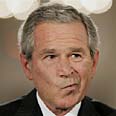
Ahmadinejad, Bush: More similar than different?
Some common threads seem to link two men, both in terms of their rise to power and their views on religion, state
Both are highly controversial in their home countries and abroad, and would at first glance seem to be polar opposites. Yet, some common threads seem to link the two men – both in terms of their rise to power and their views on religion and the state.
Both men are leaders with shadowy pasts and a strong spiritual bent. To understand both Ahmadinejad’s and Bush's similarities, it is vital to analyze their rise to power. Both were outsiders on their respective national stages, and used this status to gain entrance into politics.
As the former governor of Texas, Bush was a presidential underdog at first in the 2000 US election. Critics argued that his lack of foreign policy experience and relative obscurity to the American public were major handicaps to his campaign.
However, the election’s result showed that Bush's reputation as an outsider enabled him to persuade socially conservative voters that he would restore morality to the scandal -ridden Presidency and would be able, because he was an outsider, to end Washington’s political gridlock.
Similarly, Ahmadinejad emerged in Iranian politics as an outsider coming from a lesser post as mayor of Tehran. In a strikingly similar tactic as Bush, Ahmadinejad used his outsider’s position to provide an alternative to frustrated voters.
Religious elections
Election results from the US in 2004 revealed a country divided to the core and put the political divisions between rural and urban areas into focus. The Bush campaign was effective in appealing to red (rural) state voters who emphasized “moral values” deemed higher than their blue state counterparts’ when picking a candidate.
Interestingly, Ahmadinejad appealed to a similar rural population of Iran just as Bush had to rural America through a mix of social conservatism and promises to improve the lot of Iran’s underclass.
In both the US’s 2004 and Iran’s 2005 elections, religion’s role in politics was greatly increased. Both Bush and Ahmadinejad were able to tap into feelings of marginalization among conservative religious groups that were frustrated by liberal political forces in their countries.
Even more interestingly, the percentages of both countries’ populations who would classify themselves as religiously conservative are roughly the same.
According to estimates by Hadi Semati of the Woodrow Wilson International Center, approximately 35 percent of Iranians support religious conservative candidates. According to a 1993 Gallop poll of Americans, 33 percent of Americans agreed with the statement, "The Bible is the actual word of God and it is to be taken literally, word for word."
Similar roads
Once in office, these two leaders have also taken similar roads, particularly with regard to foreign policy.
Ahmadinejad, only a year into his Presidency, has aggressively pursued a policy of developing nuclear technology, and has not shied away from confrontations with the United Nations and the world’s great powers. Ahmadinejad's strong anti-American and anti-Israel rhetoric has persuaded many that moderation in Iran is truly dead and that Iran is a threat to the West.
Similarly, Bush, who had campaigned as something of an isolationist, was able to use the terrorist attacks of 9/11 to launch an aggressive foreign policy in the Middle East, a policy whose self-stated aims are the democratization of the Middle East and thus the elimination of threats to Israel and American interests.
Bush has also abandoned the US’s usual position of maintaining the moral high ground, and has used similar threatening, confrontational and aggressive rhetoric, stating that "You are either with us or against us" on fighting terrorism, and labeling North Korea, Iran and Iraq as an “axis of evil.”
In both countries, this rhetoric serves to shore up their respective power bases, which are inclined to nationalism and viewing foreign policy issues in black and white.
Deserts of Arabia, steppes of Asia
Perhaps the greatest similarity between these two leaders is that their success or failure lies in the deserts of Arabia and the steppes of Asia. Both men know we are entering a new historical epoch, and both seem determined, however misguided their methodology, to put their country’s national interests above all else, whatever the risk to the rest of the world.
Bush has continually rejected the notion of speaking with Iran's president and generally rejected the idea of negotiating with Iran over its nuclear aspirations. It is time for citizens of both countries to recognize how extremist their leaders have become, and what a danger to the world and to their own security such nationalism and extremism can be.
The citizens of Iran and the US should recognize that they are not all that different, that they in many ways share the same aspirations and goals, and that while their cultures are quite different, they have leaders who share remarkably similar traits. It is this common ground that will open up dialogue and prevent the unthinkable.
Stephen Coulthart is a recent graduate of the State University of New York, where he studied political science and public justice. Courtesy of Common Ground News Service www.commongroundnews.org










